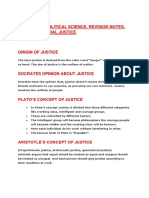In this unit we will learn
• Introduction
• Meaning of Justice
• Plato’s Theory of Justice
• Aristotle’s theory of Justice
• Amartya Sen’s theory of Justice
• John Rawl’s theory of Justice
• Nozick’s theory of Justice
�Introduction
• The term 'justice' implies the quality of being `just', right' or 'reasonable’.
• It is opposed to what is 'unjust’, 'wrong' or 'unreasonable’.
• It embodies an ideal, which is akin to the 'absolute truth' yet it is a dynamic idea because our realization of that
ideal and our comprehension of that absolute truth is a continuous process.
• Our progress in this direction depends upon the development of our social consciousness, so that what was
regarded as just some centuries ago is not so regarded today.
• Slavery and serfdom were wide `justified’ in ancient and medieval Europe; untouchability was 'justified' in India a
few decades ago; the inferior status of women was taken for granted the world over not so long ago; racial
discrimination was 'justified' till recently in some parts of the world.
• But these conditions are now widely regarded as unjust.
• Our changing outlook about these problems and changing public opinion in favor of human liberty and equality are
ample proof of the dynamic character of the idea of justice.
�Types of Justice
1. Distributive Justice: Distributive justice ensures that resources and benefits are divided fairly among individuals and
groups, like distributing slices of cake evenly among friends.
2. Environmental Justice: Environmental justice aims to prevent marginalized communities from bearing the
disproportionate burden of environmental pollution or hazards, such as clean air and water access in all neighborhoods.
3. Social Justice: Social justice advocates for equal rights, opportunities, and treatment for all members of society, regardless
of their background or identity, like ensuring equal access to education for every child.
4. Legal Justice: Legal justice focuses on the fair and impartial application of laws and the proper functioning of the legal
system, such as guaranteeing a fair trial for all individuals.
5. Political Justice: Political justice ensures that citizens have an equal and fair voice in government decisions, elections, and
policymaking, like a system that allows every eligible voter to participate freely.
6. Economic Justice: Economic justice strives to reduce income inequality and create a fair economic system that provides
opportunities and resources for everyone, such as policies that address wage disparities.
�Plato's Theory of Justice:
• Plato thought that a just society is like a well-functioning human body.
• He believed that justice exists when every part of society does its job and people stick to their roles.
• In Plato's ideal society, there are three classes: rulers, soldiers, and workers.
• Rulers make decisions, soldiers protect the society, and workers provide goods and services.
• Example:
• Imagine a school as a mini-society. The principal (ruler) makes important decisions about the school.
• Teachers (soldiers) ensure that students are safe and learn well.
• Custodians, cooks, and other staff (workers) provide the necessary services.
• In this school, if everyone does their job correctly and students follow the rules, the school is just, just like Plato's ideal
society.
• If a teacher starts making rules like the principal or a cook tries to teach a class, it becomes unjust because people aren't
doing their proper roles.
• So, Plato's theory of justice is about everyone knowing their place and doing their job in society, just like different parts of
the body have their roles for the whole body to stay healthy.
�Aristotle's Theory of Justice:
• Aristotle, the ancient Greek philosopher, had a different perspective on justice compared to Plato. He believed that justice
is about treating people fairly and giving them what they deserve. Let’s see Aristotle's view of justice:
1. Distributive Justice: This type of justice is about distributing resources and rewards in a fair way based on people's merit or
contribution. In other words, it's giving people their fair share according to their worth.
• Example: Imagine a teacher giving grades to students. Distributive justice means that the students who studied and did
well on their exams should receive higher grades than those who didn't put in the effort.
2. Retributive Justice: Retributive justice is about punishment. It suggests that people who do wrong should be punished in a
way that matches the severity of their wrongdoing. It's like the principle of "an eye for an eye."
• Example: In a legal system, if someone steals from another person, retributive justice would mean that the punishment for
the thief should be proportional to the value of what was stolen.
3. Commutative Justice: Commutative justice is about fairness in exchanges and transactions between individuals. It's like
ensuring that when you make a deal or trade with someone, both parties get what they agreed upon.
• Example: If you buy a book online and pay for it, commutative justice means you should receive the book in the condition
described. If the seller sends you a damaged or different book, that wouldn't be fair, and it would be a breach of
commutative justice.
�Amartya Sen's Theory of Justice:
• Amartya Sen, a renowned philosopher and economist, has a unique perspective on justice.
• He believes that justice is about removing the barriers that prevent people from living the kind of life they have reason to
value.
• In simpler terms, it's about giving people the freedom and opportunities to make choices and lead fulfilling lives.
• Example: Imagine two people, Alice and Bob, both of whom use wheelchairs due to disabilities.
• To Sen, justice means providing accessible infrastructure, education, and healthcare so that Alice and Bob can live full and
independent lives.
• It's not just about treating everyone the same, but recognizing and addressing individual needs to ensure that each person
has the opportunity to pursue their own goals and happiness.
• In Sen's view, justice goes beyond simply distributing resources equally; it involves creating a society where everyone has
the capability to lead a life they have reason to value.
• This approach emphasizes the importance of removing social, economic, and political obstacles that limit people's choices
and opportunities.
�John Rawls’ theory of Justice:
• John Rawls, a modern political philosopher, had a different perspective on justice.
• He proposed a theory called "justice as fairness," which is about creating a fair and just society by imagining a "veil of
ignorance."
• Justice as Fairness: Rawls asks us to imagine that we are in a room behind a "veil of ignorance."
• Behind this veil, we don't know anything about ourselves—our age, gender, talents, or social status.
• We also don't know how fortunate or unfortunate we'll be in this society.
• Example: Think of a cake-cutting scenario.
• If you and your friends are asked to divide a cake but don't know who will get which slice, you would try to make it as fair
as possible.
• You wouldn't want to take a smaller slice in case you end up with less cake.
• Rawls argues that if we design a fair society from behind this "veil of ignorance," we would create rules and systems that
benefit everyone because we wouldn't want to risk being in an unfairly disadvantaged position once the veil is lifted.
• So, justice, according to Rawls, means creating a society where everyone has a fair shot, regardless of their personal
characteristics, and where inequalities benefit everyone, especially those who are the least advantaged.
�Amartya Sen Vs John Rawls’ theory of Justice:
• Amartya Sen's approach to justice differs from John Rawls in significant ways. Rawls uses the "veil of ignorance" to design
a just society, imagining that people don't know their personal characteristics and creating rules that would be fair for
anyone. Sen, however, focuses on capabilities and real freedoms. He assesses justice by examining what people can
actually do and be in their lives.
• For instance, Sen considers whether individuals have the capability to access education, healthcare, and make choices that
lead to valuable lives.
• A key distinction lies in their measures of justice. Rawls emphasizes the distribution of primary goods, such as income and
wealth, while Sen values real freedoms and opportunities.
• Sen also takes a more relational view, addressing social inequalities that may hinder people from achieving their
capabilities, thereby affecting the well-being of others in society.
• For example, two countries with the same average income may appear just according to Rawls, but Sen would consider
whether people in both countries have the real freedom to access essential services and participate fully in society. Sen's
approach leans towards reducing inequalities and enhancing capabilities, offering a broader perspective on justice
compared to Rawls' focus on fairness under the veil of ignorance and primary goods.
�Nozick's Theory of Justice:
• Nozick's theory is built on the idea of individual rights and property rights.
• He believes that people have the right to own property and use it as they see fit, as long as they acquire it through just
means (like working for it, receiving it as a gift, or buying it) and don't use force or fraud.
• Example: Imagine two friends, Alice and Bob, starting with equal amounts of money.
• Alice decides to use her money to buy a bicycle, which she then uses to give people rides for a fee.
• Over time, she earns more money. Bob, on the other hand, decides not to buy a bicycle and keeps his money.
• In Nozick's view, both Alice and Bob have made just choices.
• Alice used her resources to create a service, and Bob kept his money, exercising his property rights.
• Nozick argues that if Alice decides to share her earnings with Bob voluntarily, that's perfectly fine.
• But the government should not step in and force Alice to share her earnings with Bob, as long as her actions are just and
voluntary.
• Critics argue that Nozick's theory can lead to unequal outcomes and neglects the need for a safety net for those who
might be less fortunate or face disadvantages.
• However, Nozick's theory emphasizes individual freedom and property rights as fundamental to justice.
�In this unit we learned
• Introduction
• Meaning of Justice
• Plato’s Theory of Justice
• Aristotle’s theory of Justice
• Amartya Sen’s theory of Justice
• John Rawl’s theory of Justice
• Nozick’s theory of Justice
�Previous Years’ Questions
1. What is meant by Justice as fairness? Explain Rawl’s theory of justice. (2023/10)
2. Discuss whether Amartya Sen's idea of justice is an improvement upon Rawl's theory of justice.(2021/20)
3. Discuss critically the distributive theory of justice as propounded by M. Nozick. (2021/10)



































































































